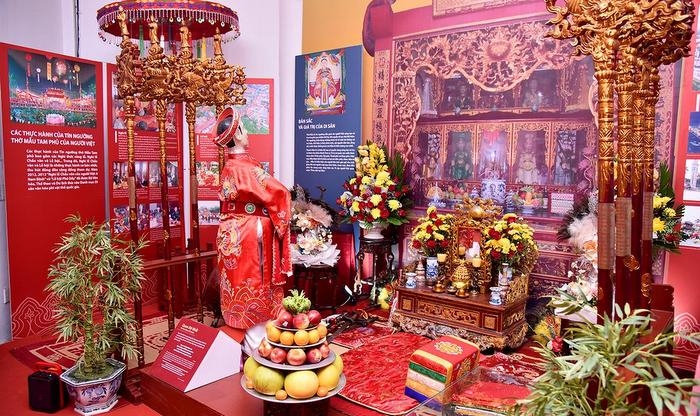An exhibition, entitled “Vietnamese Cultural Heritage Space”, officially opened at the Vietnam Exhibition Centre for Culture and Arts in Hanoi on November 22, as part of the activities to mark Vietnam Cultural Heritage Day (November 23).

The worship of Mother Goddesses of the Three Realms is introduced at the exhibition. (Photo: NDO)
The exhibition is an important cultural event, aiming to honour cultural heritages, nature, and unique landscapes of Vietnam, especially those that have been honoured by UNESCO.
The event will also be held online from November 24 to December 31 via websites http://trienlamvhnt.vn and http://dsvh.gov.vn.
Visitors to the exhibition will be given an overview of the formation and impressive development of Vietnamese cultural heritages through various activities, particularly the space for “Vietnamese intangible cultural heritages”.
The space features nearly 100 photos on intangible cultural heritages around the country, 13 of which have been recognised by UNESCO, such as Bac Ninh Quan ho (Love duet) singing, Hue Royal Court Music, the cultural space of gongs in Central Highlands, Southern Don Ca Tai Tu (traditional musical art form of the south) Festival, ca tru (ceremonial singing), and Then singing.
Specifically, Nam Dinh Province’s Museum introduced the worship of Mother Goddesses of the Three Realms, providing a basic and general view of the values of this religion – an intangible cultural heritage of humanity.

The space introducing Thanh Hoa Province's cultural heritages. (Photo: NDO)
On the occasion, the provinces of Tuyen Quang, Lang Son, Thanh Hoa and Gia Lai have also promoted their typical cultural colours and traditional handicraft products, foods and specialties.
Under the framework of the exhibition “Vietnamese Cultural Heritage Space”, the 83 most outstanding photos, which were selected from over 1,700 entries to the first National Cultural Heritage Photo Contest are displayed, aiming to promote the cultural, scientific, historical and aesthetic values of the cultural heritages to the Vietnamese people and international friends.
In addition, Ao Dai (Vietnamese traditional long dress), art photos on heritages and tourism projects associated cultural heritages are showcased, thus helping visitors to learn more about the land and people of Vietnam as well as attracting more foreign tourists to the country.